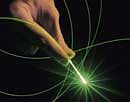Moments of impact

1 Another earth-like planet? A giant planet nearly three times as large as the Earth and made almost entirely of water has been spotted in orbit around a dim but not too distant star, improving the odds that habitable planets may exist in our cosmic neighbourhood. Astronomers detected the planet, 40 light years away in a constellation called Ophiuchus and have named it GJ1214b. The planet has a radius 2.7 times as large as the Earth’s and orbits at a distance of only two million kilometres from its star.
2Decoding the genome A decade after the human genome project laid bare the building blocks of life, scientists have figured out how they work together to create a living person. The genome project identified about 25,000 genes that are needed to make a healthy human being, but said nothing about how they combine to produce everything from hearts and minds to legs and livers. Researchers in California published what is effectively the first manual to show how genes are orchestrated inside cells - a milestone that promises to revolutionise scientists’ understanding of human development and how it can sometimes go wrong.
3Missing link First, they said it was the “first link in human evolution”. We are talking about Ida, the 47 million-year-old fossil. Then, a team of scientists clarified that it is no such thing. They say that Ida is, instead, from a “group of extinct primates” that are “not ancestors” to humans. The team identified Ida as having lived at around the time the biological order of primates was splitting into distinct branches. Ida was exciting because of her lack of lemur-like physical characteristics – no fused teeth in the middle of her lower jawbone, no grooming claw – suggesting she was from the newly developed “human branch” of primates.
4 Charles Darwin’s bicentenary The year belonged to Charles Darwin as the world celebrated the bicentenary of the intellectual figure who gifted mankind with the most important work in history- the Origin of Species. The publication completed 150 years. The truth of natural selection was waiting to be described, but Darwin nailed it and fully deserves the credit. Yes, Alfred Russell Wallace independently came up with the same theory, but, sadly, second. Darwin’s work fundamentally altered the position of humankind in the universe.
5 Galileo’s 400th anniversary While many people loudly celebrated this year’s double commemoration of 200 years since Charles Darwin’s birth and 150 years since the publication of the Origin of Species, another scientific anniversary crept up relatively quietly, marking an event which arguably changed human thought and the way we see ourselves even more irrevocably. The year marked the 400th anniversary of Italian astronomer and philosopher Galilei Galileo’s creation, a telescope. On August 25, 1609, he showed Venetian merchants his new creation, a telescope – the instrument that was to bring him both scientific immortality and, more immediately, a whole lot of trouble.
6 Unravelling the brain Scientists working on the Blue Brain Project in Switzerland are the first to attempt to “reverse-engineer” the mammalian brain by recreating the behaviour of billions of neurons in a computer. Professor Henry Markham, director of the project at the Ecole Polytechnique Fédérale de Lausanne, has already simulated parts of the neocortex, the most ‘modern’ region of the brain, which evolved rapidly in mammals to cope with the demands of parenthood and social situations. Markham’s team created a 3D simulation of around 10,000 brain cells to mimic the behaviour of the rat neocortex.
7Dark discovery In a series of coordinated announcements at several US laboratories, researchers said they believed they had captured dark matter in a defunct iron ore mine half a mile a the bottom of the mind in Minnesota in US. The claim, if confirmed next year, will rank as one the most spectacular discoveries in physics in the past century. Tantalising glimpses of dark matter particles were picked up by highly sensitive detectors in the mine, scientists said.
8Destination moon Nasa’s plans to establish a human outpost on the moon received a surprise boost following the discovery of large amounts of water on its surface. Three spacecraft detected a thin sheen of water locked up in the first few millimetres of lunar soil. Instruments aboard the spacecraft suggest that a cubic metre of soil on the lunar surface could hold around a litre of water. The space agency is developing a new generation of rockets and crew capsules capable of reaching the moon which are due to fly within five years of the space shuttle fleet being retired next year.
9Recreating the big bang Scientists claimed a world record by crashing particles together at the highest energy achieved in a laboratory. Physicists at the Cern nuclear research organisation near Geneva working on the Large Hadron Collider recorded head-on collisions between beams of protons at an energy of 2.36 trillion electron volts. The machine is designed to recreate the conditions in the moments after the big bang. Scientists hope it will help them to identify the Higgs boson, which gives other particles mass, and reveal the nature of dark matter, the invisible substance that clusters around galaxies.
10Solar eclipse The longest ever time the moon blocked the sun. The year saw the longest total solar eclipse of the 21st century so far. Visible only in Asia, it reached its peak in India. The eclipse lasted for three minutes and 48 seconds. Scientists from across the world flocked various cities and villages in India to view the spectacle. Also, to study the effects of the eclipse on animals, birds and among other natural life.
(Compiled from The Guardian)
Deccan Herald is on WhatsApp Channels| Join now for Breaking News & Editor's Picks